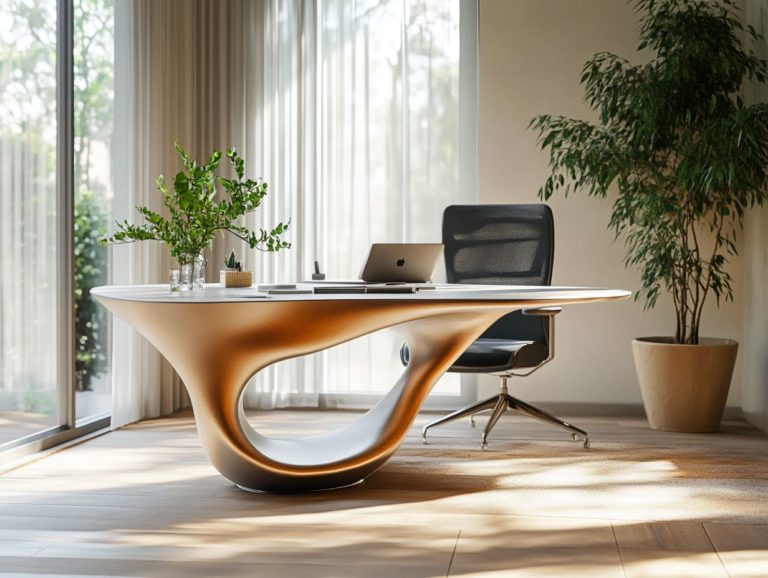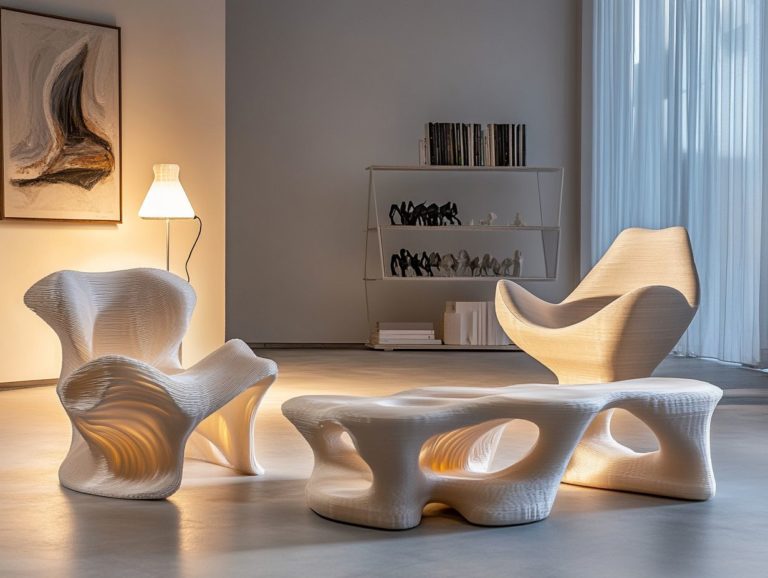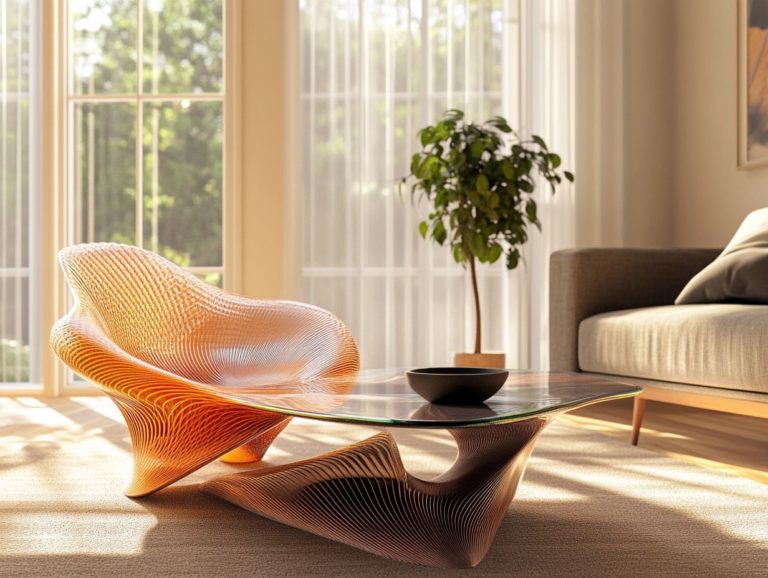5 Facts You Didn’t Know About 3D-Printed Furniture
3D printing has revolutionized the way you perceive furniture, seamlessly blending technology with creativity in ways that inspire. Get ready to explore five intriguing facts about 3D-printed furniture that are sure to surprise you!
From its extensive history and environmental advantages to the endless design possibilities it offers, 3D printing is transforming how you furnish your spaces. You’ll delve into the materials involved, explore the future of this innovative sector, and discover standout examples highlighting its remarkable potential.
Prepare to uncover a new dimension in furniture design!
Contents
- Key Takeaways:
- 1. 3D Printing Technology Has Been Around for Decades
- 2. 3D-Printed Furniture Is Sustainable and Environmentally Friendly
- 3. The Possibilities for Design and Customization Are Endless
- 4. 3D-Printed Furniture Can Be Made from a Variety of Materials
- 5. The Future of 3D-Printed Furniture Is Promising
- What Is 3D Printing and How Does It Work?
- Frequently Asked Questions
Key Takeaways:

- 3D printing has been transforming furniture design for decades.
- It promotes sustainability by reducing waste.
- Enjoy personalized, unique designs tailored just for you.
1. 3D Printing Technology Has Been Around for Decades
3D printing technology, initially brought to life by Chuck Hull in the 1980s using a method called stereolithography, has undergone remarkable evolution. It has introduced advanced techniques reshaping industries such as healthcare, aerospace, and entertainment.
As a versatile form of additive manufacturing which builds objects layer by layer 3D printing has paved the way for a myriad of applications, from 3D-printed organs to intricate artistic designs. Its significance in today s technological landscape is undeniable.
Milestones like selective laser sintering and fused deposition modeling have further amplified this technology s potential. In healthcare, innovations such as bioprinting have opened new frontiers, enabling the creation of customized implants and even viable tissue structures tailored to individual patients.
In the manufacturing sector, 3D printing has become popular for streamlining production processes, minimizing material waste, and enhancing design flexibility. These advancements showcase the transformative power of additive manufacturing while highlighting its vital role in tackling complex challenges across diverse fields.
2. 3D-Printed Furniture Is Sustainable and Environmentally Friendly
3D-printed furniture offers a sustainable and environmentally friendly solution. It allows for the use of sustainable materials while significantly reducing waste compared to traditional production methods, making it essential to understand the technology behind 3D-printed furniture.
This innovative approach harnesses advanced manufacturing techniques that incorporate biodegradable plastics, recycled materials, and even organic composites. All these dramatically lower the environmental impact associated with creating furniture.
By utilizing additive manufacturing, you can produce items layer by layer, effectively eliminating excess material and sidestepping the energy-intensive processes typical of conventional methods. As a consumer, you have the opportunity to enjoy customizable designs tailored to your specific needs, aligning seamlessly with your eco-conscious values.
These advancements in 3D printing not only encourage more responsible consumption but also inspire a collective movement towards a greener future, where sustainability is intricately woven into the fabric of everyday living.
3. The Possibilities for Design and Customization Are Endless
With 3D printing, the design and customization possibilities are virtually limitless! You can leverage CAD software to craft bespoke pieces that cater to your unique preferences and needs.
This powerful software streamlines the design process, enabling you to create intricate geometries and shapes that were once considered impossible. By embracing this technology, industries like furniture design are undergoing a revolution, allowing for the creation of unique pieces tailored to specific spaces and styles.
Other sectors, such as fashion and automotive, are also tapping into these capabilities, producing everything from customized eyewear to specialized components. The fusion of innovative design and cutting-edge printing techniques unlocks a new realm of creativity, where both artists and engineers can bring their visions to life.
Dive into the world of 3D-printed furniture and see how it can transform your living space!
4. 3D-Printed Furniture Can Be Made from a Variety of Materials
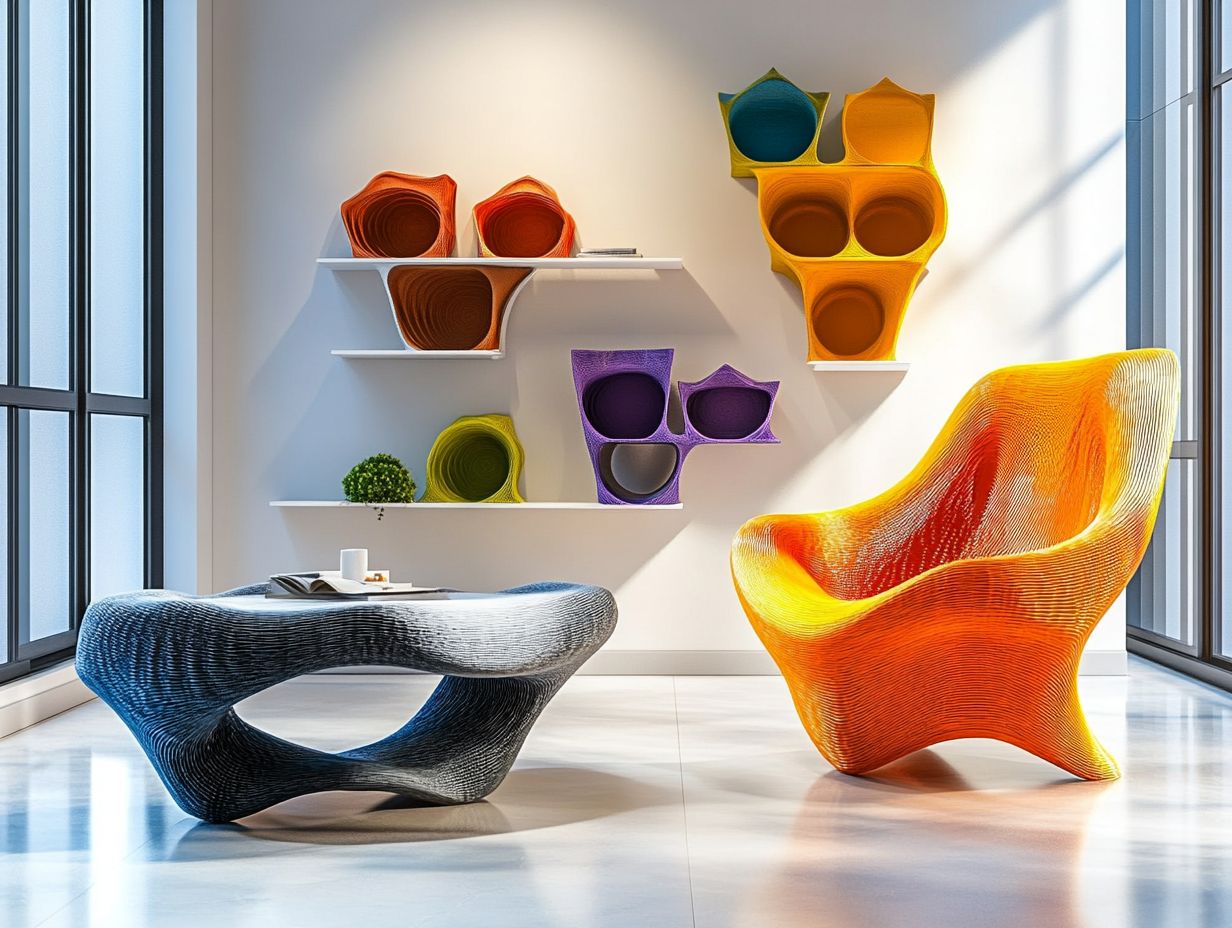
3D-printed furniture offers you an impressive range of materials, from sustainable choices to cutting-edge composites. For those looking to enhance their space, exploring must-have 3D-printed furniture items allows for both functional and artistic innovations.
This diverse palette enables you to explore a wide array of textures, colors, and finishes. It significantly enhances the aesthetic allure of each piece.
Eco-friendly materials like bio-based plastics and reclaimed wood not only promote environmental sustainability but also align with your growing desire for greener alternatives.
With advancements in multi-material printing, you can seamlessly combine different materials within a single creation. This results in unique design elements and improved performance characteristics.
These innovations unlock opportunities for intricate designs that elevate the overall user experience. They merge utility with creativity in the realm of furniture design.
5. The Future of 3D-Printed Furniture Is Promising
The future of 3D-printed furniture is exciting and full of possibilities! Advancements in technology continue to evolve and seamlessly integrate sustainable practices. To stay informed, check out the trends in 3D-printed furniture that will transform your approach to home decor.
As manufacturers adopt cutting-edge materials and precision printing techniques, you can look forward to a diverse array of customizable designs. These cater to your unique needs and aesthetic preferences.
These innovations unleash creative potential for designers while significantly minimizing waste. They support environmentally responsible production methods.
With 3D printing technology becoming more accessible, local artisans and small businesses can flourish in this competitive landscape. This trend is crucial for artisans and small businesses to thrive and make a mark in this rapidly evolving landscape!
The integration of smart technology within furniture designs can revolutionize how you interact with your environment. It provides functionalities tailored to modern lifestyles while ensuring sustainability remains a priority in this dynamic market.
What Is 3D Printing and How Does It Work?
-
3D printing is a way to build things by adding material layer by layer. It allows you to create three-dimensional objects from digital designs.
-
Leveraging advanced printing technology and computer-aided design (CAD) software, you can layer materials to construct intricate models. The process begins with your digital blueprint, which is carefully transformed into physical layers, each one adhered to the layer beneath it.
-
The choice of materials whether plastics, metals, or even biological substances significantly influences the properties of the final object. This technology has established important niches in various industries.
-
In healthcare, for instance, it facilitates the production of customized prosthetics and medical implants tailored to individual needs. In aerospace, it contributes lightweight components that enhance fuel efficiency in aircraft designs.
-
Meanwhile, in the entertainment industry, filmmakers and game developers utilize 3D printing to create detailed prototypes and sets. This demonstrates its versatility and transformative potential across diverse sectors.
What Are the Benefits of 3D Printing Furniture?
The advantages of utilizing 3D printing for furniture are remarkable. They offer enhanced customization options, minimize waste through efficient production processes, and provide the opportunity to incorporate sustainable materials that promote a healthier environment.
Imagine transforming your living space with unique pieces that truly reflect you! By embracing 3D printing, you can personalize your furniture to align perfectly with your unique needs and preferences, creating pieces that reflect your aesthetic and functional requirements.
You have the freedom to select dimensions, colors, and textures that harmoniously work together with your existing d cor. The 3D printing process produces only what you need, significantly reducing off-cuts compared to traditional methods.
This not only minimizes waste but also slashes costs associated with excess material. The use of eco-friendly options such as biodegradable plastics reinforces the ongoing push toward sustainability, encouraging a thoughtful approach to consumption.
As these innovations continue to unfold, the manufacturing sector finds itself at a crucial juncture. This transformation promises not just efficiency but also a commitment to a healthier planet, elevating conventional consumer applications into a more responsible and creative industry. Now is the time to leverage 3D printing for your furniture needs!
How Does 3D-Printed Furniture Compare to Traditional Furniture?

3D-printed furniture sets itself apart from traditional options in several compelling ways. It presents advantages like rapid prototyping, intricate design capabilities, and a significantly lower environmental impact during manufacturing. For those interested in this innovative approach, here are 5 tips for designing your own 3D-printed furniture.
Unlike conventional furniture, which often entangles you in lengthy manufacturing timelines and a rigid design framework, 3D-printed pieces can be crafted in a remarkably short amount of time. This efficiency meets the fast-paced demands of today’s discerning consumers and encourages designers to venture into complex shapes and structures that were once deemed impractical. However, it’s important to consider the right approach; here are 5 questions to ask before buying 3D-printed furniture.
This production method also minimizes waste, aligning perfectly with the growing consumer preference for sustainable alternatives. These key differences have prompted many buyers to rethink their choices, gravitating towards customized, eco-friendly solutions that resonate with their unique tastes and lifestyles.
What Are the Potential Challenges of 3D-Printed Furniture?
Despite its transformative potential, 3D-printed furniture encounters several hurdles that you should be aware of, such as market acceptance, production limitations, and the ongoing need for advancements in materials and printing technology. However, it’s worth exploring the unique benefits of 3D-printed furniture as they can offer innovative solutions to these challenges.
These challenges make consumers hesitant. Many individuals remain skeptical about the durability and aesthetic appeal of 3D-printed items, often gravitating toward traditional furniture options that they view as more reliable.
Additionally, the production processes can be slow and costly, which hampers scalability in today s fast-paced market. We need to find creative solutions, such as improved material composition, faster printing techniques, and robust marketing strategies.
By highlighting the versatility and sustainability of 3D-printed furniture, you can significantly boost its acceptance. These creations not only offer unique designs but also contribute to a more eco-friendly future, making them an attractive choice for the conscious consumer. Additionally, 5 ways 3D-printed furniture can save you money further emphasize their value.
What Are the Different Types of 3D Printed Furniture Available?
The world of furniture made with 3D printing presents an impressive array of options. You can find custom designed pieces crafted specifically for your spaces. Many of these items are functional and made from sustainable materials, and there are many reasons to consider 3D-printed furniture. This innovation showcases the remarkable versatility and adaptability of the technology.
Consider categories like ergonomic chairs that provide personalized comfort. You might also explore modular shelving units that effortlessly adjust to fit various room configurations. Imagine striking accent pieces that enhance your decor and spark intriguing conversations.
Picture a living room featuring a uniquely shaped coffee table or a home office with a desk designed to fit perfectly into that snug corner. It highlights the seamless blend of craftsmanship and technology.
The appeal of custom designs goes beyond aesthetics. They cater to your unique needs and fundamentally transform how you furnish your home and office.
What Are Some Innovative Examples of 3D Printed Furniture?
Innovative examples of furniture made with 3D printing showcase striking artistic creations. These include functional household items and customizable pieces that truly reflect your personal style. They highlight the vast creative potential of this technology.
These pieces do more than serve practical purposes; they embody the cutting-edge intersection of art and utility. For instance, the unique ‘Nesting Tables’ feature organic forms that challenge conventional aesthetics while maximizing space efficiency in modern apartments.
Similarly, the ‘3D Printed Chair’ merges comfort with stunning visual appeal. It features intricate lattice structures a design made of many small, crisscrossed pieces that are both lightweight and supportive. The beauty of this technology lies in its ability to allow you to personalize designs, enabling you to select colors, patterns, and shapes that resonate with your distinct tastes.
Each creation becomes not just a piece of furniture but a true reflection of your identity.
Frequently Asked Questions
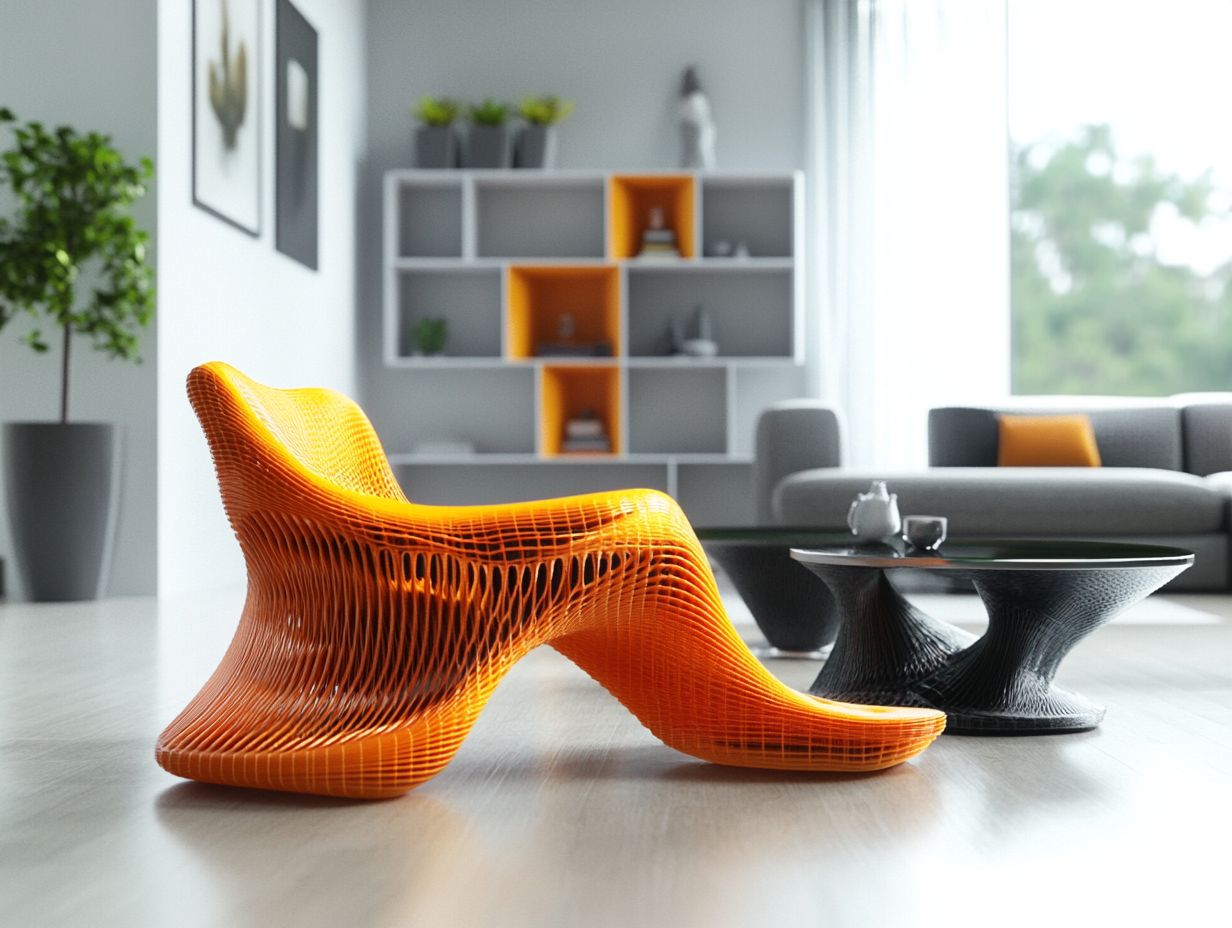
What is 3D printed furniture?
3D printed furniture is created using a 3D printer, which allows for the creation of three-dimensional objects from a digital file.
What are the benefits of 3D printed furniture?
Benefits of 3D printed furniture include its customizable nature, cost-effectiveness, and the ability to discover unique 3D-printed furniture concepts that showcase complex designs.
Can 3D printed furniture be used for everyday purposes?
Yes, furniture made with 3D printing is functional and durable, making it suitable for everyday use.
How does 3D printing technology work for furniture?
3D printing technology uses a digital design to create layers of material, such as plastic or metal, which are then fused together to form a solid object.
Is 3D printing environmentally friendly?
3D printing can be environmentally friendly as it uses less material and produces less waste compared to traditional manufacturing methods. The environmental impact depends on the materials used and the disposal of the final product.
What types of furniture can be 3D printed?
Virtually any type of furniture can be 3D printed, including chairs, tables, lamps, and even entire buildings. The possibilities with this technology are expansive!
Discover how 3D printing can revolutionize your space today!

